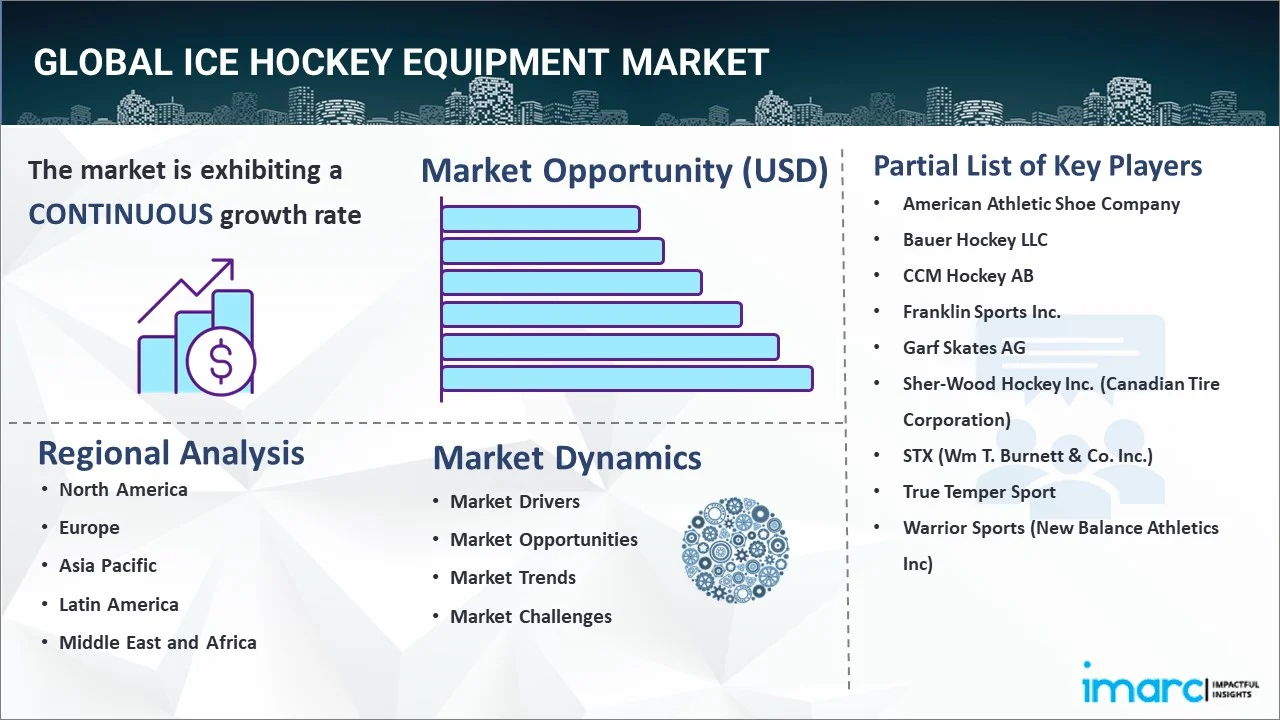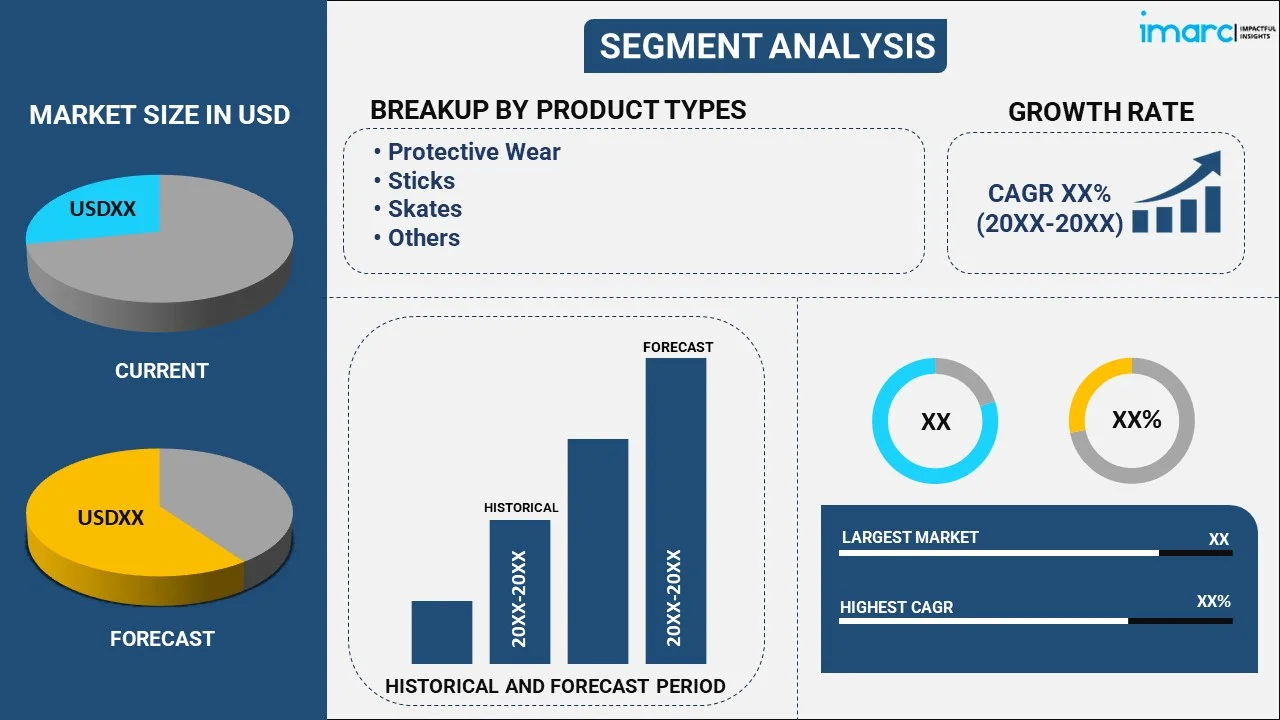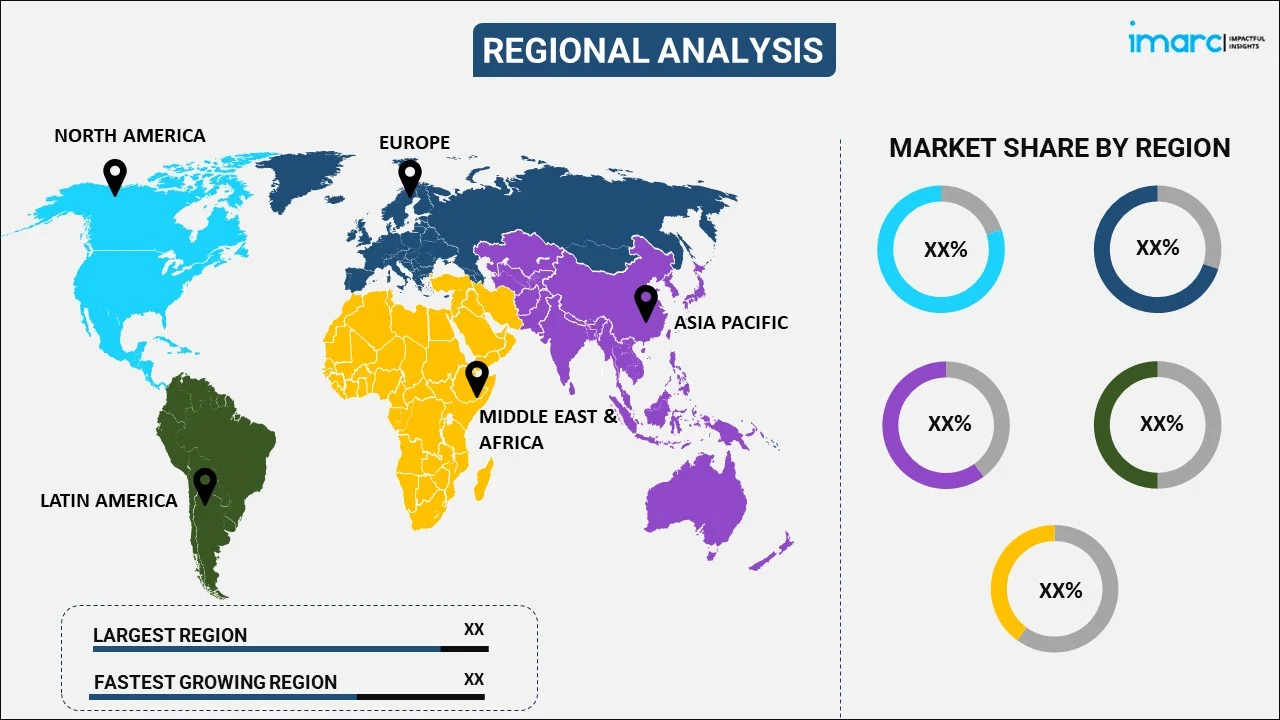
Ice Hockey Equipment Market Report by Product Type (Protective Wear, Sticks, Skates, and Others), Distribution Channel (Online Retail Stores, Offline Retail Stores), End User (Individual, Institutional, Promotional), and Region 2025-2033
Market Overview:
The global ice hockey equipment market size reached USD 1.41 Billion in 2024. Looking forward, IMARC Group expects the market to reach USD 2.00 Billion by 2033, exhibiting a growth rate (CAGR) of 3.72% during 2025-2033. North America represents the leading region due to the increasing participation, expansion of ice hockey arenas, and the growing adoption of ice hockey robots. Additionally, the increasing consumer interest, easy availability of ice hockey equipment via online retail channels, and initiatives by governing authorities to promote ice hockey as a professional winter sport represent some of the key factors driving the market growth.
|
Report Attribute
|
Key Statistics
|
|---|---|
|
Base Year
|
2024
|
|
Forecast Years
|
2025-2033
|
|
Historical Years
|
2019-2024
|
|
Market Size in 2024
|
USD 1.41 Billion |
|
Market Forecast in 2033
|
USD 2.00 Billion |
| Market Growth Rate 2025-2033 | 3.72% |
Ice hockey is a team sports played between two teams of skaters on an ice rink using various equipment, such as a helmet, stick, skates, gloves, neck and chest protector, mouthguard, and leg, shin, and arm pads. Ice hockey equipment facilitates the play of the game and protect the bodies of the players from bruises and severe fractures. It offers support to the chest, ribs, abdominal nerve plexus, spine and shoulders against flying pucks and collisions. It also protects the ginglymoid joint and arm bones from sticks, skates, and falls. It is commonly available in various materials, types, and designs and offers customization options to meet the requirements of individuals. At present, there is a rise in the demand for ice hockey equipment across the globe due to the rising consumer interest in ice hockey.

To get more information on this market, Request Sample
Ice Hockey Equipment Market Trends:
Growing Consciousness of Player Safety
Consciousness about player safety is on the rise and remains a major factor driving the demand for superior protective equipment in the market for ice hockey gear. With increasing fears of concussions, broken bones, and long-term health consequences, parents, players, and sports leagues are giving importance to helmets, pads, gloves, and mouthguards that are providing enhanced protection without affecting mobility. Manufacturers are meeting the demand by incorporating impact-absorbing materials, cutting-edge padding technology, and ergonomic products that minimize injury hazards and maximize comfort. The trend is strongest in youth and amateur markets, where parents are prioritizing safety as an essential criterion when buying gear. Regulatory bodies and leagues are mandating better safety standards, which is further driving mass usage of certified protection gear. For instance, starting with the 2025-2026 ice hockey season in Colorado, three new regulations will be implemented. The puck is deemed unplayable if it stops on top of the goal, between the crossbar and the frame. The National Federation of High Schools’ website states that the regulation further explains the rules regarding pucks that are outside the goal netting and beneath the crossbar. The game goes on in this case. As these safety standards are becoming stricter, the market is constantly investing in research and development (R&D) to provide products that are responding to changing safety expectations and consumer worries.
Growth in Youth Participation and Grassroots Initiatives
Participation of youths in ice hockey is growing at a fast pace, and this demographic trend is becoming a key growth driver for the equipment segment. Schools, clubs, and community organizations are promoting youth programs that are getting children onto the ice at a young age. Governments and federations are spending on infrastructure, training, and development programs that are opening up ice hockey in both established and new markets. Parents are consistently spending on entry-level gear, with an emphasis on safety and value, which is driving sales of helmets, padding, and sticks designed for kids. This rising youth participation is generating a long-term growth cycle, with players entering at a young age being more apt to carry on through higher levels, creating sustained demand for more-sophisticated equipment over the long term. A lot of championship tournaments are also taking place around the world, thereby driving the need for ice hockey equipment. In 2025, the 2025 IIHF Ice Hockey World Championship took place in Stockholm, Sweden, and Herning, Denmark, from 9–25 May 2025. A total of 16 teams played, split into two groups of 8 players.
Expansion of E-Commerce and Digital Retail Channels
Ice hockey gear market is witnessing great pace with the fast growth of digital retail platforms and e-commerce. Customers are depending on online shops to have access to more varieties of brands, compare prices, and check product performance before they make a purchase. Online experiences are being upgraded by retailers through virtual try-on capabilities, interactive product demonstration, and sophisticated sizing guides mimicking the in-store environment. Social media campaigns and influencer collaborations are also assuming a central role in making brand recognition and generating traffic to online platforms. While on-line shopping becomes more convenient and accessible, the on-line market is ever-growing its impact, making e-commerce one of the most robust drivers of growth in the ice hockey equipment market. IMAR Group predicts that the global e-commerce market is projected to attain USD 214.5 Trillion by 2033.
Ice Hockey Equipment Market Growth Drivers:
Technological Changes in Equipment Design
The equipment market for ice hockey is being led by ongoing technological advances, with players launching new advanced materials and clever technologies that are revolutionizing player experience. Lightweight carbon composites, high-performance polymers, and moisture-wicking materials are being employed to accelerate agility, durability, and comfort. At the same time, digital technologies like 3D scanning and bespoke fitting solutions are making equipment accessible with improved accuracy, providing an optimal fit and lower risk of injury. The convergence of wearable sensors and performance-tracking technology is bringing yet another layer to the market because players and coaches are tapping into real-time data to enhance training and track performance. This technology is of interest not just to professional athletes but also to amateur players who are looking for the same advantages. As innovation is increasingly becoming a key competitive differentiator, manufacturers are constantly investing in R&D, making sure that product development is keeping pace with changing player expectations.
Professional Endorsements and Sponsorships
Professional endorsements and sponsorship deals are ever pushing brand awareness and customer demand in the ice hockey equipment market. Professional athletes are demonstrating new and innovative sticks, helmets, and protective equipment, and in the process, generating aspirational value for amateur players, as well as youth players. These sponsorships are impacting purchasing behaviors, with players wanting to emulate the equipment of their sports icons. Brand-club sponsorships are validating brand authenticity and providing ongoing product visibility through live TV games and tournaments. Additionally, professional alliances are stimulating constant product development, as manufacturers develop closely with top athletes to optimize performance elements and safety requirements. This collaboration not only defines product design but is also increasing brand loyalty in several consumer groups. By associating with prominent athletes and organizations, brands are developing their market presence consistently and driving long-term growth in equipment demand.
Increased Focus on Sustainability and Green Products
Sustainability is emerging as a major trend in the ice hockey equipment industry as individuals and manufacturers are giving ever-increasing significance to eco-friendly practices. Players are looking at ever-growing interest in green products that are minimizing environmental footprints without losing out on performance or safety. Manufacturers are reacting by embracing recyclable materials, streamlining waste in production, and introducing greener packaging methods. This focus on sustainability is keeping pace with larger trends in the global sporting goods industry, in which environmentally conscious customers are driving brand policy and product development. Furthermore, certain manufacturers are adding trade-in or recycling programs that are driving responsible consumption and more loyal customers. As concern about the environment mounts, companies that are embracing sustainable approaches are standing out in a competitive market. This increasing focus on sustainability is not only influencing existing consumer behavior but is also helping the market move in the direction of long-term ecological objectives.
Key Market Segmentation:
IMARC Group provides an analysis of the key trends in each segment of the global ice hockey equipment market, along with forecasts at the global, regional, and country level from 2025-2033. Our report has categorized the market based on product type, distribution channel, and end user.
Product Type Insights:

- Protective Wear
- Sticks
- Skates
- Others
The report has provided a detailed breakup and analysis of the ice hockey equipment market based on the product type. This includes protective wear, sticks, skates, and others. According to the report, protective wear represented the largest segment.
Distribution Channel Insights:
- Online Retail Stores
- Offline Retail Stores
A detailed breakup and analysis of the ice hockey equipment market based on the distribution channel has also been provided in the report. This includes online and offline retail stores. According to the report, offline retail stores accounted for the largest market share.
End User Insights:
- Individual
- Institutional
- Promotional
A detailed breakup and analysis of the ice hockey equipment market based on the end user has also been provided in the report. This includes individual, institutional, and promotional. According to the report, individuals accounted for the largest market share.
Regional Insights:

- North America
- United States
- Canada
- Asia-Pacific
- China
- Japan
- India
- South Korea
- Australia
- Indonesia
- Others
- Europe
- Germany
- France
- United Kingdom
- Italy
- Spain
- Russia
- Others
- Latin America
- Brazil
- Mexico
- Others
- Middle East and Africa
The report has also provided a comprehensive analysis of all the major regional markets that include North America (the United States and Canada), Asia Pacific (China, Japan, India, South Korea, Australia, Indonesia, and others), Europe (Germany, France, United Kingdom, Italy, Spain, Russia, and others), Latin America (Brazil, Mexico, and others), and the Middle East and Africa. According to the report, North America was the largest market for ice hockey equipment. Some of the factors driving the North America ice hockey equipment market included the increasing participation, expansion of ice hockey arenas, and the growing adoption of ice hockey robots.
Competitive Landscape:
The report has also provided a comprehensive analysis of the competitive landscape in the global ice hockey equipment market. Detailed profiles of all major companies have also been provided. Some of the companies covered include:
- American Athletic Shoe Company
- Bauer Hockey LLC
- CCM Hockey AB
- Franklin Sports Inc.
- Garf Skates AG
- Sher-Wood Hockey Inc. (Canadian Tire Corporation)
- STX (Wm T. Burnett & Co. Inc.)
- True Temper Sport
- Warrior Sports (New Balance Athletics Inc)
Kindly note that this only represents a partial list of companies, and the complete list has been provided in the report.
Ice Hockey Market Equipment News:
- June 2025: WeSports Scandinavia AB enhances its standing in the ice hockey sector through the acquisition and collaboration with Skatertown ApS Skatertown ranks as one of Denmark's leading sellers of ice hockey gear, achieving revenues of around 20 MDKK with strong profitability in 2024.
- June 2025: Seven7 is excited to share its co-investment with prominent Nordic private equity firm Altor in the earlier disclosed acquisition of CCM, a renowned and inventive brand in global hockey. The investment from Altor and Seven7 marks a significant new phase for CCM, centered on global growth, digital evolution, product development, and enhanced connection with the upcoming generation of players and supporters.
- March 2025: Pure Hockey, a leading source for hockey gear, clothing, and accessories, revealed its newest expansion by acquiring Off The Bench in Omaha, NE. This tactical decision signifies Pure Hockey's initial foray into Nebraska and highlights the company's dedication to meeting the demands of hockey players throughout the United States.
- January 2025: Northleaf Capital Partners, a worldwide private markets investment firm, announced today that its managed funds have finalized an investment in CCM Hockey. Northleaf collaborated with Altor Equity Partners (“Altor”), a prominent private equity firm focused on the European middle market, to purchase the company.
- October 2024: Altor Fund VI has acquired a significant majority stake in CCM Hockey, aiming to accelerate growth opportunities and unlock new market segments. The partnership between Altor and CCM Hockey is expected to propel the iconic brand's growth journey, leveraging Altor's expertise in backing renowned consumer brands. Today, CCM is a leading designer, manufacturer and marketer of high-performance hockey equipment, accessories, figure skates and apparel.
Report Scope:
| Report Features | Details |
|---|---|
| Base Year of the Analysis | 2024 |
| Historical Period | 2019-2024 |
| Forecast Period | 2025-2033 |
| Units | Billion USD |
| Segment Coverage | Product Type, Distribution Channel, End User, Region |
| Region Covered | Asia Pacific, Europe, North America, Latin America, Middle East and Africa |
| Countries Covered | United States, Canada, Germany, France, United Kingdom, Italy, Spain, Russia, China, Japan, India, South Korea, Australia, Indonesia, Brazil, Mexico |
| Companies Covered | American Athletic Shoe Company, Bauer Hockey LLC, CCM Hockey AB, Franklin Sports Inc., Garf Skates AG, Sher-Wood Hockey Inc. (Canadian Tire Corporation), STX (Wm T. Burnett & Co. Inc.), True Temper Sport, Warrior Sports (New Balance Athletics Inc), etc |
| Customization Scope | 10% Free Customization |
| Post-Sale Analyst Support | 10-12 Weeks |
| Delivery Format | PDF and Excel through Email (We can also provide the editable version of the report in PPT/Word format on special request) |
Key Benefits for Stakeholders:
- IMARC’s report offers a comprehensive quantitative analysis of various market segments, historical and current market trends, market forecasts, and dynamics of the ice hockey equipment market from 2019-2033.
- The research study provides the latest information on the market drivers, challenges, and opportunities in the global ice hockey equipment market.
- The study maps the leading as well as the fastest growing regional markets. It further enables stakeholders to identify the key country-level markets within each region.
- Porter's five forces analysis assist stakeholders in assessing the impact of new entrants, competitive rivalry, supplier power, buyer power, and the threat of substitution. It helps stakeholders to analyze the level of competition within the ice hockey equipment industry and its attractiveness.
- Competitive landscape allows stakeholders to understand their competitive environment and provides an insight into the current positions of key players in the market.
Key Questions Answered in This Report
The global ice hockey equipment market was valued at USD 1.41 Billion in 2024.
We expect the global ice hockey equipment market to exhibit a CAGR of 3.72% during 2025-2033.
The rising participation of individuals in recreational sports and fitness activities, along with the growing consumer awareness regarding the benefits of performing ice hockey, such as improving focus and balance, promoting weight management, strengthening bones and muscles, etc., is primarily driving the global ice hockey equipment market.
The sudden outbreak of the COVID-19 pandemic has led to the changing consumer inclination from conventional brick-and-mortar distribution channels towards online retail platforms for the purchase of ice hockey equipment.
Based on the product type, the global ice hockey equipment market can be bifurcated into protective wear, sticks, skates, and others. Currently, protective wear holds the majority of the total market share.
Based on the distribution channel, the global ice hockey equipment market has been segmented into online retail stores and offline retail stores, where offline retail stores currently exhibit a clear dominance in the market.
Based on the end user, the global ice hockey equipment market can be divided into individual, institutional, and promotional. Currently, individual accounts for the largest market share.
On a regional level, the market has been classified into North America, Asia-Pacific, Europe, Latin America, and Middle East and Africa, where North America currently dominates the global market.
Some of the major players in the global ice hockey equipment market include American Athletic Shoe Company, Bauer Hockey LLC, CCM Hockey AB, Franklin Sports Inc., Garf Skates AG, Sher-Wood Hockey Inc. (Canadian Tire Corporation), STX (Wm T. Burnett & Co. Inc.), True Temper Sport, Warrior Sports (New Balance Athletics Inc), etc.
Need more help?
- Speak to our experienced analysts for insights on the current market scenarios.
- Include additional segments and countries to customize the report as per your requirement.
- Gain an unparalleled competitive advantage in your domain by understanding how to utilize the report and positively impacting your operations and revenue.
- For further assistance, please connect with our analysts.
 Request Customization
Request Customization
 Speak to an Analyst
Speak to an Analyst
 Request Brochure
Request Brochure
 Inquire Before Buying
Inquire Before Buying




.webp)




.webp)












